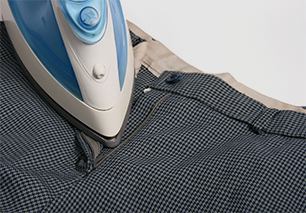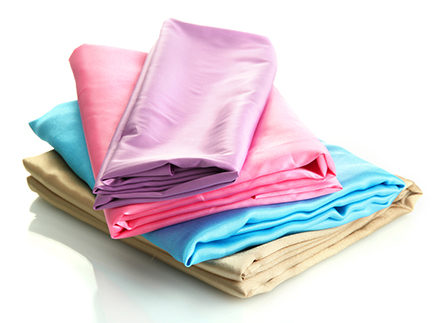Ironing Tips

Use these ironing tips to press garments with ease.
- Before ironing, check garment label and follow manufacturer’s instructions. If instructions do not exist, start with a low-heat setting and test by ironing a small area, then gradually increase heat.
- Sort garments by fabric type. Iron articles requiring a low-temperature setting first, then gradually work up the temperature range.
- When changing from a high-temperature setting to a lower setting, allow 5 minutes for temperature change.
- When steam ironing, use long, slow passes over the fabric for steam to penetrate fabric and allow the heat off the soleplate to dry any moisture.
- If the garment is lined, use a low heat setting.
- Ensure zippers are closed and flaps are flat. Iron over flaps, holding the garment taut.
- Spray starch makes the job easier and helps to press in crisp creases.
Ironing Shirts

Use these ironing tips to press shirts to crisp, professional look.
- When ironing cotton dress shirts, use the cotton setting and plenty of steam. Iron lengthwise, not in circles.
- Begin with the collar and work toward the middle from the outer edges.
- Lay shoulder over narrow edge of the board and iron one side of the front. Then, iron the shoulder, across the back (below the collar line), then the other shoulder and finally the remainder of the front.
- Iron sleeves and cuffs, working down from the underarm seams. To remove creases, shift the double layer of sleeve fabric and iron out.
- Iron body of garment, from half of the front around the back, then second half of front. If your shirt does not open, slip over end of ironing board and iron front and back in turn.
Ironing Pants

Use these ironing tips to press pants and trousers to creased perfection.
- Begin with the waistband and inseam area, then pockets and cuffs.
- Pull waistband on pointy end of the board, as if you’re “dressing” the ironing board. Iron upper-front part of the pants, including the waistband.
- Place pants parallel to ironing board lengthwise so both legs are facing the same direction. Iron each leg by moving the iron back and forth along the pant leg.
- Take cuff of the leg and bring it over towards the waistband to iron the inner part of the leg. Repeat these 2 steps for the second leg.
- Hang pants up when ironing is completed, either by the waistband or by the cuffs, or on a shirt hanger, by folding them in half and maintaining the creases.
Tips for Ironing Specific Fabrics

Acetate
When ironing acetate, use a low temperature setting and no steam. Turn the fabric inside out to prevent shine marks.
Acrylic
When ironing acrylic, turn the fabric inside out, set the temperature to a low setting and do not use any steam. Use a spray if necessary. Make sure to iron the fabric while it is completely dry, so it doesn’t stretch out of shape
Corduroy
When ironing corduroy, turn the garment inside out and use a heavy ironing cloth. Then, use your hand to smooth the fabric.
Cotton
Iron cotton while the fabric is still damp, or pre-moisten it with a spray bottle. Set the temperature to a high setting and use steam for stubborn wrinkles and creases.
Cotton-Blend
Iron cotton-blends on low heat and use steam. Iron the garment inside out or place a press cloth, such as a clean cotton handkerchief or fabric scrap, between the iron and the fabric to prevent iron marks and shine.
Denim
Iron denim on the highest heat setting and use steam. Use starch for crisp, neatly creased fabric.
Linen
Iron linen garments inside out or place a press cloth, such as a clean cotton handkerchief or fabric scrap, between the iron and the fabric to prevent shine. Always iron linen while the fabric is still damp, or pre-moisten it with a spray bottle. Use spray-on starch or fabric sizing for collars, cuffs or any other areas that you want to make crisp.
Nylon
When ironing nylon, use the lowest temperature setting on the iron and place a press cloth, such as a clean cotton handkerchief or fabric scrap, between the iron and the fabric. If necessary, convert to the “Steamer” function to gently remove wrinkles from nylon.
Polyester
When ironing polyester, make sure the fabric is slightly damp, or pre-moisten it with a spray bottle. Set the temperature to low or medium heat. Start ironing at the top and work your way down the garment, pressing firmly on the creases and re-wetting them if necessary.
Rayon
When ironing rayon, turn the garment inside out, set the temperature to low heat and don’t use any steam. Iron one small area at a time to avoid stretching.
Silk
Iron silk while the fabric is still damp, or pre-moisten it with a spray bottle. Turn the garment inside out before ironing, and set the temperature to the lowest heat setting. Place a press cloth, such as a clean cotton handkerchief or fabric scrap, between the iron and the fabric to prevent shine.
Viscose
Iron viscose while the fabric is still damp, or pre-moisten it with a spray bottle. Set the temperature to the lowest setting and use a dry iron unless otherwise noted on the tag. Place a press cloth, such as a clean cotton handkerchief or fabric scrap, between the iron and the fabric to prevent shine.
Wool & Wool-Blends
Iron wool and wool-blends on low heat and use steam (ironing wool while it is dry can damage the fabric). Turn the garment inside out to prevent iron marks and shine.
Window Decor
Drapes can easily be steamed using the Vertical Shot of Steam® feature while hanging in place. Start at the top and continue down in a straight line. Steaming your drapes on a regular basis can help eliminate spots, odors and wrinkles.


